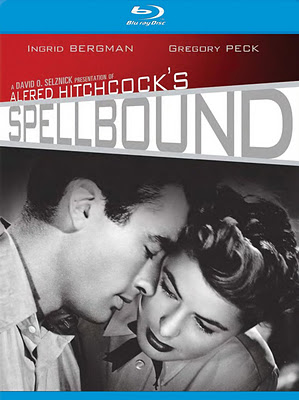Spellbound review by Jackass Tom
It had been a few years since I had seen Spellbound and I wrote down a list of what I remembered about the film from my previous viewings several years earlier:
And for the period, I remember having high hopes for this Hitchcock film based mostly on the Dali sequence, and also on Ingrid Bergman and Gregory Peck being the headliners. But it fell slightly short of expectations. Again as stated above, one hears about Dali and you hope it’s more than 90 seconds.
On to probably my third or fourth viewing! What is the movie about? Dr. Anthony Edwardes (played by Gregory Peck, not Anthony Edwards) arrives at Green Manor as the new, young shrink. Another young shrink, Dr. Constance Petersen (Ingrid Bergman), who is compared emotionally to a notebook by one of her male peers, starts to fawn like a school girl as soon as Edwardes shows up. This despite moments where he spouts out awkward comments like, “I take it the supply of linen at this institution is inexhaustible!” (cue the Therimin) In one scene Dr. Petersen shows up to a table of her peers, hair a mess and stocking torn from a windy walk outside and she gets the once over from the fellas, (“Gentlemen notice her stocking. The lady’s been climbing trees!” “Or lolling in a briar patch”) Human Resources didn’t exist at Green Manor; it was a simpler time.
But the mystery doesn’t stop with strange statements at dinner tables. After an episode or two, Edwardes reveals in a moment of clarity that the real Edwardes was killed and he took his place but he can’t remember much more than that due to amnesia. Luckily for him, the dreamy-eyed Dr. Petersen is there to use the powers of psychoanalysis to help him unlock the doors holding the mystery as opposed to turn him over to the authories.
The film plods along for the first 30-45 minutes, picks up and then plods some more. There is an awkward negotiation of feelings between the Florence Nightingale-ish Dr. Petersen and the fake Dr. Edwardes. At times Edwardes practically confesses that he is the murderer; not fazing Dr. Petersen at all. This is coupled with Petersen’s psychoanalysis sessions that work more like witchcraft. Usually by the end of it Edwardes is ready to physically collapse or emotionally boiling over to the point where he is on the brink of violence. Cute couple.
For a romance, there is little romance. For a thriller there are relatively few moments of danger until just past the hour mark and most of it is in the “Will this man completely snap and kill the bookworm psychologist?” When the thrills do heat up, Hitchcock also starts to get clever with the camera (POV shots, strategic lighting of Edwardes, framing of a razor blade, and of course, the Dali dream sequence). The film feels more like a vehicle for Hitchcock to whip out a few clever tricks for about 20 minutes but overall the film is weak.
And yes, the dream sequence. It starts at about 1:26:50 and ends at 1:29:27 and is broken up with some discussion of the dream in between. The sequences themselves are beautifully shot and staged. On their own they could be the beginning of a surrealist short film. Ala Un Chien Andalou:
The scene itself is reason enough to watch the film, and it was a novel idea to use surrealism to show a man’s dream. Much as I remembered it, the film is so slow in so many spots and uses an early, unrealistic use of psychoanalysis to push the story forward. This could probably be overlooked if the story had been better. There are moments in the film that are fun to watch and work well within a 90 minute documentary of Hitchcock but as a whole its not one of Hitch’s better works.





5 out of 10 Jackasses blog comments powered by Disqus
